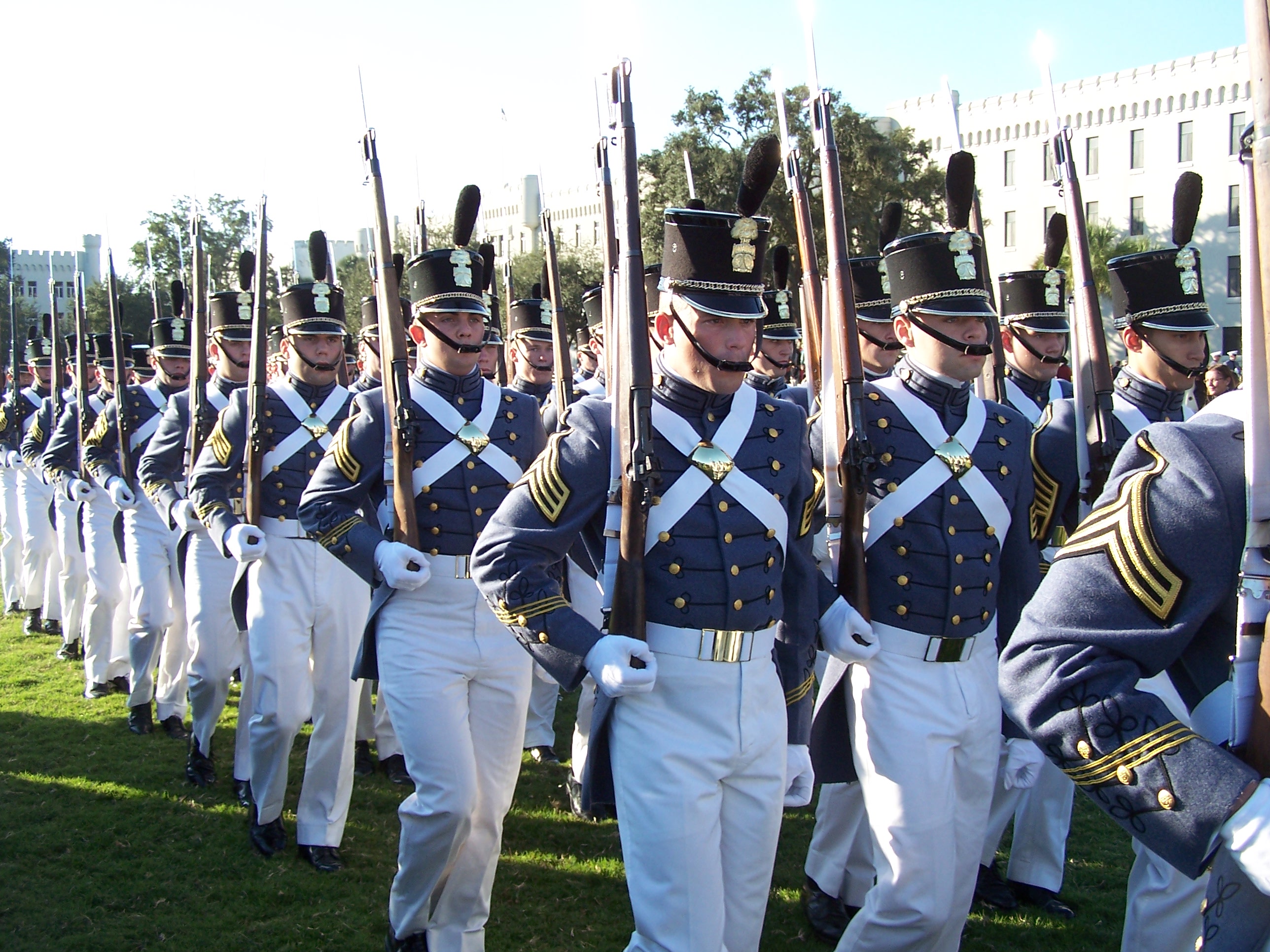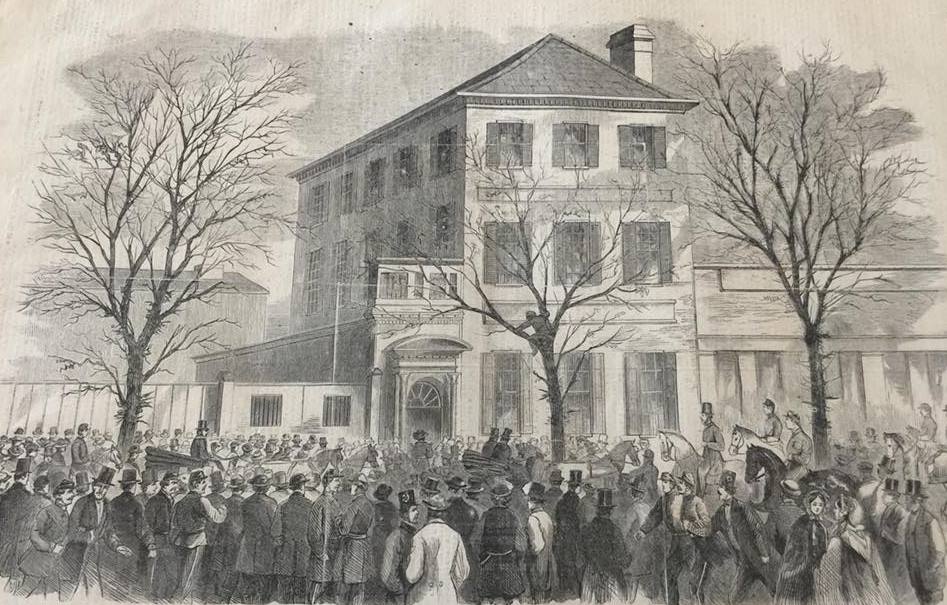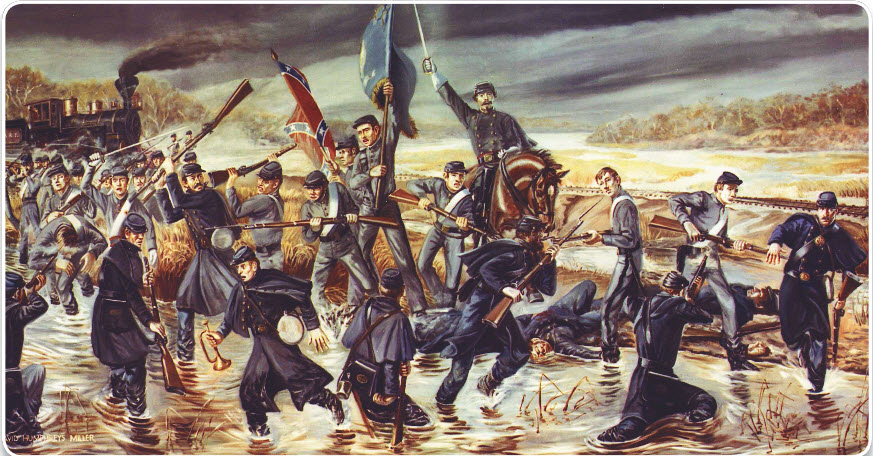|
South Carolina Military Academy
The South Carolina Military Academy was a predecessor, two-campus institution to The Citadel. It was established in 1842 by the South Carolina Legislature. South Carolina had constructed a series of arsenals around the state after the Denmark Vesey planned slave revolt of 1822; these were consolidated into Columbia and Charleston arsenals. No longer seen as militarily necessary, they became in 1842 the South Carolina Military Academy, consisting of the Arsenal Academy in Columbia and the Citadel Academy in Charleston. During the Civil War students from both served as the Battalion of State Cadets; classes continued, with interruptions. SCMA cadets fired the first shots of the Civil War on January 9, 1861 while manning a gun emplacement on Morris Island, South Carolina which shelled the Union steamship Star of the West; the Battalion of State Cadets made up over a third of a Confederate force that defended a strategic rail bridge in the Battle of Tulifinny in 1864, the only occasion ... [...More Info...] [...Related Items...] OR: [Wikipedia] [Google] [Baidu] |
The Citadel
The Citadel, The Military College of South Carolina, commonly known simply as The Citadel, is a Public college, public United States senior military college, senior military college in Charleston, South Carolina. Established in 1842, it is one of six senior military colleges in the United States. It has 18 academic departments divided into five schools offering 31 majors and 57 minors. The military program is made up of cadets pursuing bachelor's degrees who live on campus. The non-military programs offer 12 undergraduate degrees, 26 graduate degrees, as well as evening and online programs with seven online graduate degrees, three online undergraduate degrees, and three certificate programs. The South Carolina Corps of Cadets numbers 2,300 and is one of the largest uniformed bodies in the U.S. Approximately 1,350 non-cadet students are enrolled in The Citadel Graduate College, Citadel Graduate College pursuing undergraduate and graduate degrees. Women comprise approximately 9% ... [...More Info...] [...Related Items...] OR: [Wikipedia] [Google] [Baidu] |
South Carolina Legislature
The South Carolina General Assembly, also called the South Carolina Legislature, is the state legislature of the U.S. state of South Carolina. The legislature is bicameral and consists of the lower South Carolina House of Representatives and the upper South Carolina Senate. All together, the General Assembly consists of 170 members. The legislature convenes at the State House in Columbia. Prior to the 1964 federal ''Reynolds v. Sims'' decision by the U.S. Supreme Court, each county doubled as a legislative district, with each county electing one senator and at least one representative. Moreover, each county's General Assembly delegation also doubled as its county council, as the state constitution made no provision for local government. The "one man, one vote" provision of ''Reynolds v. Sims'' caused district lines to cross county lines, causing legislators to be on multiple county councils. This led to the passage of the Home Rule Act of 1975, which created county counc ... [...More Info...] [...Related Items...] OR: [Wikipedia] [Google] [Baidu] |
Denmark Vesey
Denmark Vesey (also Telemaque) ( July 2, 1822) was an early 19th century free Black and community leader in Charleston, South Carolina, who was accused and convicted of planning a major slave revolt in 1822. Although the alleged plot was discovered before it could be realized, its potential scale stoked the fears of the antebellum planter class that led to increased restrictions on both slaves and free blacks. Likely born into slavery in St. Thomas, Vesey was enslaved by Captain Joseph Vesey in Bermuda for some time before being brought to Charleston. There, Vesey won a lottery and purchased his freedom around the age of 32. He had a good business and a family, but was unable to buy his first wife Beck and their children out of slavery. Vesey worked as a carpenter and became active in the Second Presbyterian Church. In 1818 he helped found an independent African Methodist Episcopal (AME) congregation in the city, today known as Mother Emanuel. The congregation began with t ... [...More Info...] [...Related Items...] OR: [Wikipedia] [Google] [Baidu] |
Arsenal Academy
The Arsenal Academy was a military academy in Columbia, South Carolina, originally established in 1842 as an independent school by the state of South Carolina. In 1845, the academy became a component of the South Carolina Military Academy (now The Citadel), in which first year cadets underwent their initial year of training before completing their studies at the larger Citadel Academy in Charleston, South Carolina. The school was burned by Sherman's forces in 1865 and never reopened. History At the outset of the Civil War in 1861, the South Carolina Military Academy consisted of two institutions, both built in the 1820s as state arsenals, specifically to have the state prepared in the event of a slave revolt like that planned by Denmark Vesey (who was from Charleston). This process consolidated a number of smaller arsenals around the state to two locations, which would in 1842 be converted to military academies. The Arsenal Academy, or Arsenal Military Academy, or The Arsenal, w ... [...More Info...] [...Related Items...] OR: [Wikipedia] [Google] [Baidu] |
History Of The Citadel
The History of The Citadel began in the early 1820s with the formation of a militia and state arsenal in response to an alleged slave revolt in 1822. By 1842 the arsenal grew into an academy, with the Legislature establishing it as the South Carolina Military Academy. Cadets played a key role in the Civil War by assisting in the battalion firing upon a federal ship three months before the war began. Many Confederate officers attended the school. Renamed in 1910 as The Citadel, the school's academic reputation grew. After moving the campus near Hampton Park in 1922, the college has grown substantially. In 1969, graduate student Maxine Hudson became the first woman to earn a degree from The Citadel. The Citadel saw the graduation of its first Black student, Charles D. Foster in 1970, 16 years after legal segregation ended in public schools. Following a rocky journey, The Citadel graduated its first female Cadet, future congresswoman Nancy Mace, in 1999. The school has produced many m ... [...More Info...] [...Related Items...] OR: [Wikipedia] [Google] [Baidu] |
American Civil War
The American Civil War (April 12, 1861 – May 26, 1865; also known by other names) was a civil war in the United States. It was fought between the Union ("the North") and the Confederacy ("the South"), the latter formed by states that had seceded. The central cause of the war was the dispute over whether slavery would be permitted to expand into the western territories, leading to more slave states, or be prevented from doing so, which was widely believed would place slavery on a course of ultimate extinction. Decades of political controversy over slavery were brought to a head by the victory in the 1860 U.S. presidential election of Abraham Lincoln, who opposed slavery's expansion into the west. An initial seven southern slave states responded to Lincoln's victory by seceding from the United States and, in 1861, forming the Confederacy. The Confederacy seized U.S. forts and other federal assets within their borders. Led by Confederate President Jefferson Davis, ... [...More Info...] [...Related Items...] OR: [Wikipedia] [Google] [Baidu] |
Morris Island, South Carolina
Morris Island is an 840-acre (3.4 km²) uninhabited island in Charleston Harbor in South Carolina, accessible only by boat. The island lies in the outer reaches of the harbor and was thus a strategic location in the American Civil War. The island is part of the cities of Charleston and Folly Beach, in Charleston County. History Morris Island was heavily fortified to defend Charleston Harbor, with the fortifications centered on Fort Wagner. On January 9, 1861, the first shots of the American Civil War were fired from cannons by cadets of The Citadel at the ''Star of the West'' as the ship tried to resupply Fort Sumter. It was the scene of heavy fighting during the Union Army's campaign to capture Charleston, and is perhaps best known today as the scene of the ill-fated assault by the 54th Massachusetts Volunteer Infantry, an African-American regiment. The regiment and this assault, where it suffered over 50% casualties, was immortalized in the film '' Glory''. After the Con ... [...More Info...] [...Related Items...] OR: [Wikipedia] [Google] [Baidu] |
Star Of The West
''Star of the West'' was an American merchant steamship that was launched in 1852 and scuttled by Confederate forces in 1863. In January 1861, the ship was hired by the government of the United States to transport military supplies and reinforcements to the U.S. military garrison of Fort Sumter. A battery on Morris Island, South Carolina handled by cadets from the South Carolina Military Academy (now The Citadel) fired upon the ship, considered by some scholars to have been effectively the first shots fired in the American Civil War. The ship was later captured by Confederate forces, then used for several purposes including as a hospital ship and a blockade runner, and finally scuttled in defense of Vicksburg in 1863. Prewar service ''Star of the West'' was a 1,172-ton steamship built by Jeremiah Simonson, of New York City for Cornelius Vanderbilt, and launched on June 17, 1852. Its length was and its beam , with wooden hullside paddle wheels and two masts. She started service ... [...More Info...] [...Related Items...] OR: [Wikipedia] [Google] [Baidu] |
Battle Of Tulifinny
The Battle of Tulifinny was an American Civil War engagement fought December 6–9, 1864 in South Carolina during General Sherman's March to the Sea, also known as the Savannah Campaign. Outnumbered 5-1 a Confederate force successfully defended a critical section of the Charleston-Savannah railroad. This engagement was historically significant because it was one of the rare occasions when United States Marines fought in combat during the Civil War, in addition the Confederate forces included the entire Corps of Cadets from the South Carolina Military Academy (now The Citadel, The Military College of South Carolina, The Citadel), who comprised more than a third of the Rebel force; it is also the only occasion that the entire student body of a U.S. college fought in combat. Background In early December 1864 Major General William Tecumseh Sherman, William T. Sherman and his formidable army numbering an estimated 62,000 men approached the South Carolina border and their final obj ... [...More Info...] [...Related Items...] OR: [Wikipedia] [Google] [Baidu] |
South Carolina Governor's Mansion
The South Carolina Governor's Mansion (or the South Carolina Executive Mansion) is a historic U.S. governor's mansion in the Arsenal Hill neighborhood of Columbia, South Carolina and the official residence of the governor of South Carolina. It is a Federal style home influenced by British Colonial plantations. The building has a white stucco exterior and originally served as faculty quarters for the Arsenal Academy, which together with the Citadel Academy in Charleston formed the South Carolina Military Academy (now The Citadel). The Arsenal was burned along with the city of Columbia by Sherman's forces in February, 1865; the structure was the only surviving building and became South Carolina's executive mansion in 1868."History of the South Carolina Military Academy", Col J.P. Thomas On June 5, 1970, the building was registered with the U.S. National Register of Historic Places. The mansion is located on a single city block, and is surrounded by magnolia plants, elm and oak ... [...More Info...] [...Related Items...] OR: [Wikipedia] [Google] [Baidu] |
Defunct Universities And Colleges In South Carolina
{{Disambiguation ...
Defunct (no longer in use or active) may refer to: * ''Defunct'' (video game), 2014 * Zombie process or defunct process, in Unix-like operating systems See also * * :Former entities * End-of-life product * Obsolescence Obsolescence is the state of being which occurs when an object, service, or practice is no longer maintained or required even though it may still be in good working order. It usually happens when something that is more efficient or less risky r ... [...More Info...] [...Related Items...] OR: [Wikipedia] [Google] [Baidu] |
The Citadel, The Military College Of South Carolina
The Citadel, The Military College of South Carolina, commonly known simply as The Citadel, is a public senior military college in Charleston, South Carolina. Established in 1842, it is one of six senior military colleges in the United States. It has 18 academic departments divided into five schools offering 31 majors and 57 minors. The military program is made up of cadets pursuing bachelor's degrees who live on campus. The non-military programs offer 12 undergraduate degrees, 26 graduate degrees, as well as evening and online programs with seven online graduate degrees, three online undergraduate degrees, and three certificate programs. The South Carolina Corps of Cadets numbers 2,300 and is one of the largest uniformed bodies in the U.S. Approximately 1,350 non-cadet students are enrolled in Citadel Graduate College pursuing undergraduate and graduate degrees. Women comprise approximately 9% of the Corps and 22% of the overall enrollment while racial minorities comprise 1 ... [...More Info...] [...Related Items...] OR: [Wikipedia] [Google] [Baidu] |





.jpg)